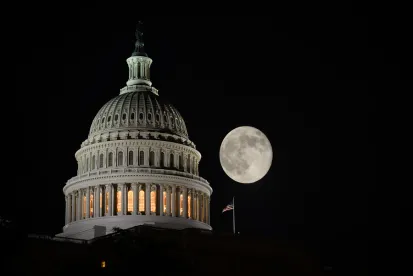Will Congress complete fiscal year 2021 appropriations before government funding expires on December 11? What challenges do House and Senate negotiators face in reconciling competing versions of spending bills? Will President Trump sign an Omnibus funding package?
As the calendar turns to December and Congress sprints to complete legislative business in the waning days of the 116th Congress, lawmakers in Washington DC are once again focused on preventing a government shutdown when federal funding lapses on December 11. While few anticipate a repeat of the 35-day impasse that shuttered government from December 22, 2018 until January 25, 2019, pressure continues to build on Congress – in the midst of the COVID-19 pandemic – to extend federal funding beyond the current Continuing Resolution (CR) that expires ten days from now.
Bipartisan, bicameral Appropriations Committee staff worked through the long Thanksgiving holiday weekend, striving to resolve differences between 12 House bills (10 approved by the full House and two that were approved by the House Committee in July) and the Senate’s 12 draft spending bills released by the Committee on November 10.
While significant progress is being made, much work remains. As negotiations continue, each of the subcommittees have identified “open items,” issues that remain unresolved and hence need to be elevated to the full Committee, or even to the highest levels of congressional leadership, for final resolution.
Before informal negotiations got underway, each of the 12 House Appropriations Subcommittees prepared “conference notes” to guide their bipartisan, bicameral discussions. Conference notes display the respective positions of the House and Senate bills and reports, and are used by the four-corners staff (House and Senate majority and minority staff of each subcommittee) to arrive at a final disposition on every word of bill language and report language, and funding levels for each agency, program, and funding line throughout each of the bills. These dispositions become the underlying foundation for each of the final, negotiated spending measures, commonly referred to as “divisions” in a multi-bill Omnibus spending package.
Upon the completion of conference notes, staff begins the process of “clearing underbrush,” or addressing relatively easy-to-resolve bill and report language issues, where there is likely to be little disagreement between the four corners. As these early stage discussions were getting underway, House and Senate Appropriations full Committees (House Chairwoman Lowey, Senate Chairman Shelby, and their respective front office staff) exchanged offers over the distribution of funds among each of the 12 subcommittees. Both sides had distinct concerns and clear priorities when it came to dividing 12 slices of the funding pie; this process, too, is subject to negotiation.
Metaphorically, the pie itself is the total amount of annual discretionary spending in fiscal year 2021 (also known as the 302(a) level) – which is set in statute at $1.375 trillion. Each slice of the pie, or the amount allotted to each Appropriations subcommittee, is commonly referred to as the 302(b) allocation. Of the total 302(a) amount for fiscal year 2021, by law $740.5 billion is allocated to defense programs and $634.5 billion is allocated to non-defense discretionary programs. To provide some additional spending flexibility outside of the spending caps, the House and Senate this year moved to exempt more than $10 billion in VA spending from these spending limits. This is a common budget gimmick; designating certain VA benefits as emergency spending frees up billions of dollars to be allocated to other non-defense priorities across multiple bills.
The House and Senate Appropriations Committees reached agreement on 12 common subcommittee allocations on November 24, just two days before Thanksgiving. While less than ideal timing, historically Committee professional staff have found it more desirable to work through the Thanksgiving holiday in order to complete and have spending bills enacted into law prior to the holidays in December. In addition to resolving major differences over funding, appropriators also face challenges this year coming to agreement over public policy concerns including the pandemic, social justice priorities, gun rights, abortion, and other pivotal issues.
House Majority Leader Steny Hoyer (D-MD), himself a former appropriator, notified lawmakers last Friday that the House would strive to complete its legislative work for the year during the week of December 7. This remains a tall order given the number of outstanding items yet to be resolved. Still, this ambitious effort reflects a bipartisan desire to complete this year’s legislative business and begin the 117th Congress in January with a clean slate.
Maintaining this ambitious timeline will require negotiations on each of the bills to be completed in the coming days, and for each of these final measures to be “read out,” a process requiring each bill, explanatory statement, and budget table to be carefully reviewed to ensure accuracy. Should additional time be required to finalize spending bills for House and Senate approval, the current CR can be extended for a short period to keep government funded beyond the current CR’s December 11 expiration.
While Congress remains committed to completing all 12 funding measures, a CR may be necessary to extend funding into the new calendar year for one or more of the annual bills where an impasse over policy or funding proves too challenging to reach consensus. The Homeland Security bill, for instance, has been among the most contentious measures during President Trump’s presidency given the challenge of reconciling immigration policy and bridging divisions over funding for a wall along the US-Mexico border.
Lastly, still largely unknown is whether President Trump, as he faces the end of his presidency, will sign an Omnibus funding package in excess of $1 trillion. This lack of certainty creates additional challenges for appropriators and congressional leaders as they work around the clock to finalize fiscal year 2021 spending decisions.




 />i
/>i

